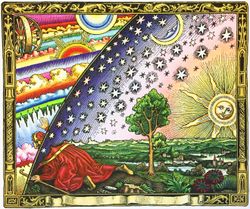Difference between revisions of "The Cosmos"
Tom Bishop (talk | contribs) |
Tom Bishop (talk | contribs) (Updating to more generalized descriptions as mentioned in 'Moon Diameter' thread on forum) |
||
| Line 11: | Line 11: | ||
==The Sun== | ==The Sun== | ||
| − | ''Main article:'' [[Sun]] | + | ''Main article:'' '''[[Sun]]''' |
| − | The | + | The Sun is a sphere which revolves above the Earth on a path known as the ecliptic. Its path moves North-South over the year between the Tropic of Capricorn to the Tropic of Cancer. It illuminates a portion of the earth at a time and has daily cycle of one revolution per 24 hours. |
==The Moon== | ==The Moon== | ||
| − | ''Main article:'' [[Moon]] | + | ''Main article:'' '''[[Moon]]''' |
| − | The Moon is a sphere | + | The Moon is a sphere which revolves above the surface of the Earth in a manner similar to the Sun. It moves at a slightly slower rate of revolution, at about 347.81° per 24 hours, rising and setting 50 minutes later each day. The Moon has a monthly phase cycle, ranging from Full Moon to New Moon. |
==The Planets== | ==The Planets== | ||
| − | ''Main article:'' [[Planets]] | + | ''Main article:'' '''[[Planets]]''' |
| − | + | The planets are spheres which move above the face of the Earth and across the sky with apparent relationship to the Sun. Known to antequity as 'wandering stars', the planets were once thought to be key to the nature of the Solar System and the Earth's place in it. | |
==The Stars== | ==The Stars== | ||
| − | ''Main article:'' [[Stars]] | + | ''Main article:'' '''[[Stars]]''' |
| − | The stars are rotating around a central point over the North Pole. The underlying cause for this rotation is a vast cornucopia of stellar systems orbiting around its center of attraction - an imaginary point of shared attraction. | + | The stars are luminous elements which move in a layer above the Sun and Moon at a rate of about one rotation every 23.93 hours. The stars are rotating around a central point over the North Pole. The underlying cause for this rotation is a vast cornucopia of stellar systems orbiting around its center of attraction - an imaginary point of shared attraction. |
==General Physics== | ==General Physics== | ||
Revision as of 07:25, 10 August 2019
The Cosmos is the name given to everything that is above the terrestrial atmoplane.
General
- Astronomy is a Pseudoscience
- Astronomical Prediction Based on Patterns
- The Three Body Problem
- Kings Dethroned
- Quotes That Tell Us We Have All Been Lied To
- Problems of the Galaxies
The Sun
Main article: Sun
The Sun is a sphere which revolves above the Earth on a path known as the ecliptic. Its path moves North-South over the year between the Tropic of Capricorn to the Tropic of Cancer. It illuminates a portion of the earth at a time and has daily cycle of one revolution per 24 hours.
The Moon
Main article: Moon
The Moon is a sphere which revolves above the surface of the Earth in a manner similar to the Sun. It moves at a slightly slower rate of revolution, at about 347.81° per 24 hours, rising and setting 50 minutes later each day. The Moon has a monthly phase cycle, ranging from Full Moon to New Moon.
The Planets
Main article: Planets
The planets are spheres which move above the face of the Earth and across the sky with apparent relationship to the Sun. Known to antequity as 'wandering stars', the planets were once thought to be key to the nature of the Solar System and the Earth's place in it.
The Stars
Main article: Stars
The stars are luminous elements which move in a layer above the Sun and Moon at a rate of about one rotation every 23.93 hours. The stars are rotating around a central point over the North Pole. The underlying cause for this rotation is a vast cornucopia of stellar systems orbiting around its center of attraction - an imaginary point of shared attraction.
General Physics
Further information: General Physics

